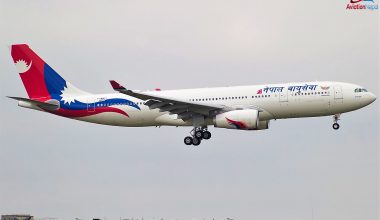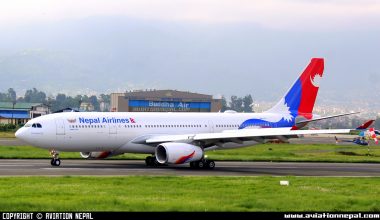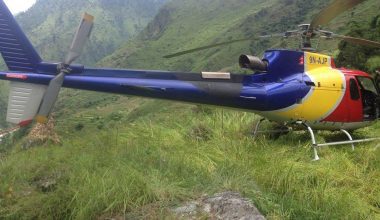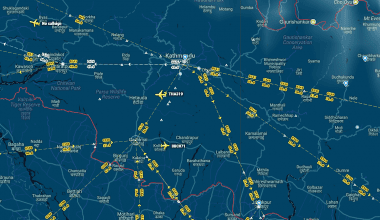The Antonov An-22 ‘Antei’ was designed by Antonov Design Bureau in the Soviet Union for heavy military transportation. The design was the first wide-body transportation aircraft, powered by four turboprops each. The aircraft remains the largest turboprop aircraft in the world to date. At the Paris Air Show in 1965, the An-22 was first published outside of the U.S.S.R. The model was then widely used in major Soviet military and humanitarian airlifts and remained in service with the Russian Air Force.

Development History of Antonov AN -22
The Soviet military wanted a huge transport aircraft to supplement the An-8 and An-12s in the late 1950s. In the early 1960s, the Antonov bureau built a wooden mock-up of the Model 100 in its Kyiv, Ukraine, workshops. As a result, the world’s largest turboprop, the An-22, was born.
Read More: 19th Century made Gigantic Aircraft, Antonov- An225 Mriya
In 1961, work on a new aircraft, which would become the An-22, began. The ability to take off and land on soft ground was the primary requirement for the new aircraft. As a result, developers installed 12 wheels in the middle of the fuselage, six on each side. Although such landing gear had some disadvantages, it was difficult to steer the aircraft on the ground due to the uneven distribution of weight. Each chassis wheel can be controlled independently. The An-22 was designed as a strategic aircraft to expand the ability of the Soviet Airborne Troops to land with their then-new BMD-1 armored vehicles. The cargo hold of the An-22 can hold four BMD-1s, whereas the cargo hold of the An-12 can only hold one.

The prototype, now known as the An-22, was unveiled on August 18 of 1964 and took to the skies for the first time on February 27, 1965. Yurii Kurlin, a test pilot, led the team. After four months of the test flight, the prototype was named Antaeus and was shown at the Paris Air Exhibition in 1965. The first military delivery was made in 1969 to the Ivanovo Airbase Air Transportation Wing. All the aircraft were built at the state aircraft factory in Tachkent of Uzbekistan.
Design and Specifications of Antonov AN -22
The four Kuznetsov NK-12 turboprop engines power the An-22 Antei. The maximum thrust of every engine is 15,001 horsepower. It is driven by two large, four-bladed, 6.2-meter high-speed propellers. The aircraft has a maximum altitude of 25,000 feet. The speed is 400 knots, and the climb rate is 1,500 meters per minute. It has 270 nautical miles, a maximum payload of 60 000 kg, maximum fuel capacity, and a maximum payload of 5 910 nautical miles and 45 000 kg. The aircraft’s fuel tank capacity is US 11,400 Gal. The weight of takeoff and landing is respectively maximum 250,000 kg and 190,000 kg.
The An-22 is a traditional cargo transport aircraft with a high-mounted wing that allows for a large cargo space of 33 m in length and a usable volume of 639 cubic meters. The forward fuselage is fully pressurized and can accommodate 5 to 8 crew members and up to 28 passengers. At frame 14, a pressure bulkhead-equipped door separates the cargo attendant’s compartment from the main cargo compartment. This enables the rear cargo doors to be opened during flight for paratrooper and equipment drops. The aircraft, like the An-12, has a circular fuselage section.

Having been built during the Soviet era when aircraft technology was still underdeveloped, the Antonov AN-22 cockpit was operated by two pilots in the front fly. Between the two pilots, a flight engineer on the engine throttles, a radio controller, a second flight engineer. In addition, a navigator sits beneath the cockpit, close to the glass nose.
The cockpit panels are painted green in the typical Soviet-style, found on many airliners and cargo aircraft. The unique cockpit contains different parts and has an analog display rather than a digital one.
Features and Records
The An-22 was the world’s largest aircraft at the time, so it made a big impression on the audience and received high marks from appraisers. Even today, the Antei is the world’s largest turboprop aircraft. It takes 1300 meters to take off, has a landing distance of 800 meters, and can operate on an unpaved runway. The maximum weight is 250,000 kg for takeoff and landing and 190,000 kilograms for each of them. The An-22 has set 14 payloads to height records, of which the most impressive was an airlift of metal blocks weighing 100 metric tons (220,500 pounds) to an altitude of 7,848 meters (25,748 feet).
With a maximum takeoff weight of 250 tons, the An-22 holds a Guinness World Record (551,156 lb). It is also the only wide-body freighter capable of landing on unpaved runways or at a remote airstrip. In Speyer, Germany, a former Ukrainian Air Force AN-22 is displayed at the Technik Museum Speyer.
Production and Operation
The production of An-22 began in 1969. Aside from military cargo, it was also used to transport agricultural equipment and humanitarian supplies to Peru and India. It was also actively used in Afghanistan for troops, combat vehicles, supply transportation, and other military conflicts. 68 aircraft were built between 1965 and 1975, of which two never flew, 19 have been preserved, 33 have been removed from service due to maintenance issues as it has become difficult to keep the aging planes airworthy, and seven have been lost in various accidents.
Six An-22s are currently in service with the 76th Military Transport Air Squadron in Tver. However, only three of them are flight-ready. The current plan is to keep the three aircraft flying until 2033, when the turbofan-powered Antonov An-124 will replace them. To date now Antonov Airlines has only one An-22, which is registered as Name UR-09307 is in service.
Accidents of Antonov AN -22
There had been nine hull losses as of January 2011, with a total of 95 fatalities. Some of the notable accidents are;
The Soviet Air Force An-22 crashed into the Atlantic Ocean on July 18, 1970. Unregulated decompression was supposed to occur but was not proven. This was the first recorded aircraft crash, which killed all 17 passengers and 15 crew.
The Russian Air Force An-22 collapsed on December 28, 2010, in central Russia’s Tula region. A malfunction or engine failure of aircraft equipment was alleged. During the accident, twelve people died.
Read More: Cuban military Antonov An-26 crashed killing 8 on board
During the Soviet invasion of Afghanistan in 1979, An-22s were used to transport airborne troops. On October 28, 1984, an An-22 was shot down shortly after takeoff from Kabul by an SA-7, killing 250 passengers and crew. Two more An-22s were lost in crashes at Moscow’s Vnukovo Airport in 1992 and Migalovo Air Base in 1994.






